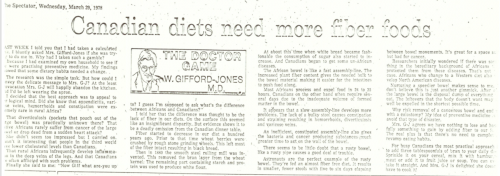Canadian diets need more fiber foods
29 Mar 1978
Last week I told you that I had taken a calculated guess when I bluntly asked Mrs. Gifford-Jones if she was trying to do me in. Why had I taken such a gamble?
Because I had examined my own household to see if we were practising preventive medicine. My findings owed that some dietary habits needed a change.
The research was the simple task. But how could I convey the delicate message to Mrs. G-J? At the least provocation Mrs. G-J will happily abandon the kitchen. And I’d be left wearing the apron.
I decided that the best approach was to appeal to her logical mind. Did she know that appendicitis, varicose veins, hemorrhoids and constipation were extremely rare in rural Africa?
That diverticulosis (pockets that pouch out of the large bowel) was practically unknown there? That Africans rarely suffer from cancer of the large bowel or drop dead from a sudden heart attack?
She didn’t seem too impressed but I carried on. Wasn’t it interesting that people in the third world have lower cholesterol levels than Canadians. That rural Africans infrequently develop inflammation in the deep veins of the legs. And that Canadians are often afflicted with such problems.
Finally she said to me, “Now Giff what are you up to? I guess I’m supposed to ask what’s the difference between Africans and Canadians?”
I told her that the difference was thought to be the lack of fiber in our diets. On the surface this seemed like an insignificant disparity. But evidence shows it to be a deadly omission from the Canadian dinner table.
Fiber started to decrease in our diet a hundred years ago. Prior to that time wheat berries were crushed by rough stone grinding wheels. This left most of the fiber intact resulting in black bread.
Then in 1880 the smooth steel rolling mill was invented. This removed the bran layer from the wheat kernel. The remaining part containing starch and protein was used to produce white flour.
At about this time when white bread became fashionable, the consumption of sugar also started to increase. And Canadians began to get some un-African diseases.
The African bowel is like a fast assembly line. The increased plant fiber content gives the needed bulk to the bowel material making it easier for the intestines to push food along.
Most Africans process and expel in 24 to 35 hours. Canadians on the other hand often require several days due to the inadequate volume of formed matter in the bowel.
It appears that a slow assembly line develops more problems. The lack of a bulky stool causes constipation and straining resulting in hemorrhoids, diverticulosis and varicose veins.
An inefficient, constipated assembly line also gives the bacteria and cancer producing substances much greater time to act on the wall of the bowel.
There seems to be little doubt that a rusty bowel, like a rusty pipe causes a good deal of trouble.
Astronauts are the perfect example of the rusty bowel. They’re fed an almost fiber free diet. It results in smaller, fewer stools with five to six days elapsing between bowel movements.
It’s great for a space but bad for cancer prevention. Researchers initially wondered if there was something in the hereditary background of Africans that protected them from these diseases. That’s not case. Africans who change to a Western diet also develop North American diseases.
Nurturing a speedier bowel makes sense to me. I don’t believe this is just another gimmick. After all the large bowel is the disposal dump of everything we eat. The leftovers that the body doesn’t want may well be expelled in the shortest possible time.
Why risk removal of a cancerous bowel and end with a colostomy? My idea of preventive medicine avoids that type of disaster.
Mrs. G-J agrees we have nothing to lose and hopefully something to gain by adding more fiber to our family diet. The real plus is that there’s no need to completely revamp eating habits.
For busy Canadians the most practical approach is to add three tablespoonfuls of bran to your daily dishes. Sprinkle it on your cereal, mix It with hamburger meat or add it to fruit juice or soup. You can even take it straight. And Mrs. G-J is delighted she doesn’t have to cook it!



